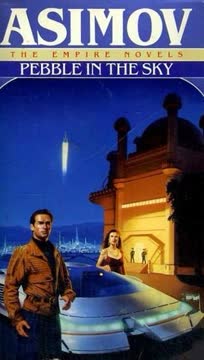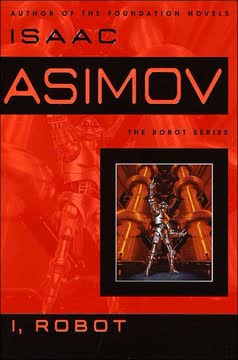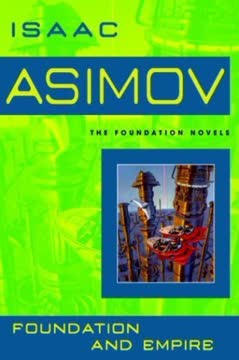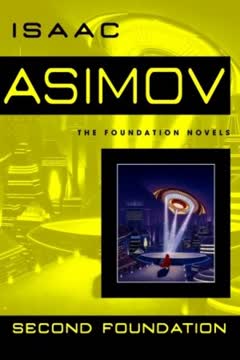Plot Summary
Between Two Steps
Joseph Schwartz, a retired tailor in 1949 Chicago, is abruptly wrenched from his world by a freak nuclear accident. In a blink, he finds himself in a wild, autumnal landscape, the city vanished, the era unrecognizable. Confused and desperate, Schwartz's first steps in this new world are haunted by the loss of everything familiar—his family, his language, his time. The shock of displacement is total, and as he stumbles through the alien countryside, the reader feels the terror and loneliness of a man utterly unmoored from his life, forced to confront the possibility that he is either mad or impossibly lost in time.
A Stranger in Time
Taken in by Arbin and Loa Maren, Schwartz is a mystery to them—mute, disoriented, and unable to communicate. Their world is harsh, ruled by strict population controls and the looming threat of the Sixty, a ritual euthanasia for the elderly. The Marens, already hiding Loa's father Grew from the authorities, debate whether Schwartz is a danger or a blessing. Their decision to keep him, hoping he can help with the farm's quota, is fraught with fear and hope. Schwartz's presence exposes the family's vulnerability and the oppressive customs of this future Earth, where survival often means complicity in cruelty.
Earth's Bitter Future
The narrative shifts to Bel Arvardan, a renowned archaeologist from the Sirius Sector, who arrives on Earth to investigate its origins. Earth, once the cradle of humanity, is now a radioactive backwater, despised and isolated by the Galactic Empire. Arvardan's theories challenge the prevailing belief that humanity evolved on many worlds, positing instead that all humans originated on Earth. His arrival is met with suspicion and hostility, both from the Earthmen, who cling to their ancient pride, and from the Imperial authorities, who fear the destabilizing potential of his research. The planet's radioactive blight and social decay are stark reminders of a civilization in decline.
The Synapsifier Gamble
Schwartz, still unable to speak or understand the language, is brought to Dr. Shekt, a neurophysicist developing the Synapsifier—a device meant to enhance learning by altering brain chemistry. The machine is experimental and deadly, but the desperate Marens see it as a chance to make Schwartz useful. Shekt, under pressure from the secretive Society of Ancients, agrees to the procedure. The operation is a success: Schwartz survives, and his mind is transformed. He rapidly acquires language and knowledge, but something deeper has changed—he begins to sense the thoughts and emotions of those around him, an awakening that will have profound consequences.
Outsiders and Outcasts
As Schwartz recovers, he is both a medical marvel and a prisoner, watched by Shekt and his daughter Pola. Meanwhile, Arvardan's journey across Earth exposes the deep-seated bigotry between Earthmen and Outsiders. On a crowded airliner, he witnesses the casual acceptance of the Sixty and the mutual contempt between the planet's inhabitants and the rest of the Galaxy. Attempts at kindness or understanding are met with suspicion or hostility. The narrative paints a world where fear, resentment, and isolation have become the norm, and where even acts of charity are tainted by the ever-present threat of betrayal.
The Sixty and the Secret
Schwartz learns the language and the customs of this new world, including the grim reality of the Sixty. The population is ruthlessly controlled, and those who cannot work are eliminated. The Society of Ancients, a shadowy organization, enforces these customs and plots in secret. Shekt, increasingly fearful for his life and his daughter's, confides in Pola about the true purpose of the Synapsifier and the dangerous knowledge he possesses. The sense of impending doom grows as the threads of conspiracy tighten around the main characters, each of whom is caught between personal survival and the fate of worlds.
Minds Awakened
Schwartz's new abilities blossom into full telepathy. He can sense, influence, and even kill with his mind. This power isolates him further, as he becomes aware of the true thoughts and intentions of those around him. The gift is both a blessing and a burden, offering the possibility of escape and agency, but also exposing him to the darkest aspects of human nature. As he experiments with his abilities, Schwartz is forced to confront the ethical implications of his power and the loneliness of being utterly unique in a hostile world.
Conspiracies in Chica
The narrative accelerates as Arvardan, Shekt, Pola, and Schwartz are drawn together by fate and necessity. The Society of Ancients, led by the cunning Secretary Balkis, is revealed to be orchestrating a planet-wide rebellion against the Empire. Their weapon is a genetically engineered virus, derived from Earth's unique mutations, capable of wiping out all non-Earth humans in the Galaxy. The conspirators' plan is both desperate and monstrous, born of centuries of oppression and exclusion. The protagonists, each with their own motives and loyalties, must decide where they stand as the deadline for catastrophe approaches.
The Web Tightens
The Society of Ancients moves swiftly to neutralize threats. Schwartz, Arvardan, Shekt, and Pola are captured and imprisoned, subjected to interrogation and psychological torment. Balkis, reveling in his apparent victory, offers them a choice: betray the Empire or face death and worse. The group's unity is tested as Schwartz, embittered by his treatment and isolation, contemplates siding with Earth's cause. The tension is palpable as the characters grapple with fear, loyalty, and the weight of their decisions, knowing that the fate of trillions hangs in the balance.
The Virus of Vengeance
In a chilling confession, Shekt explains the true nature of the Society's plan: a virus, engineered to exploit the unique biochemistry of Earth's mutated life, will be released across the Galaxy. The virus is unstoppable, and only Earthmen possess the immunity and the antidote. The plan is both a final act of revenge and a bid for power, born of desperation and centuries of humiliation. Arvardan, horrified, realizes that the odds have shifted—Earth, the weakest of worlds, now holds the power to destroy all others. The moral and existential stakes are laid bare.
The Mind That Kills
Schwartz's powers reach their zenith as he learns to control not just thoughts but actions. In a desperate gambit, he uses his abilities to paralyze and manipulate Balkis, turning the tables on their captors. The escape from the Hall of Correction is a harrowing ordeal, with Schwartz's mind straining to maintain control over the Secretary while the group navigates a city on the brink of revolt. The cost is immense—Schwartz is left exhausted and traumatized, but the group reaches the safety of the Imperial garrison, carrying with them the only hope of averting disaster.
The Prisoners' Dilemma
Safe within Fort Dibburn, the group faces a new enemy: Imperial skepticism and inertia. Their incredible story is met with disbelief, and the evidence is circumstantial at best. The Secretary, now a prisoner, uses his cunning to sow doubt and confusion, turning the tables by questioning Schwartz's identity and motives. The clock ticks down as the deadline for the virus's release approaches, and the fate of the Galaxy rests on the ability of a handful of individuals to convince the authorities of an almost unimaginable threat.
The Secretary's Triumph
In a masterful display of rhetoric and psychological warfare, Balkis convinces the Imperial authorities to delay action, arguing that the accusations are the product of delusion and manipulation. The group's unity fractures under the strain, and hope fades as the deadline passes without intervention. The Secretary's triumph is complete—Earth's plan proceeds, and the Galaxy stands on the edge of annihilation. The sense of despair is overwhelming, as the heroes are forced to confront the possibility that they have failed utterly.
The Telepath's Choice
In the darkest hour, Schwartz seizes the initiative. Using his telepathy, he escapes confinement, commandeers a plane with the help of a sympathetic pilot, and destroys the Temple of Senloo, the launch site for the virus. His actions, born of desperation and a newfound sense of belonging to all humanity, avert catastrophe at the last possible moment. The cost is great—Schwartz is left drained and forever changed—but his sacrifice redeems not only himself but the world that once rejected him.
The Last Stand at Dibburn
As the truth emerges, the Imperial authorities move to restore order and prevent further bloodshed. The Society of Ancients is dismantled, and Earth is offered a chance at redemption. The survivors—Arvardan, Pola, Shekt, and Schwartz—are celebrated as heroes, but the scars of the ordeal remain. The narrative lingers on the personal consequences of their choices, the fragility of trust, and the possibility of reconciliation between Earth and the Galaxy.
The Deadline Approaches
With hours left before the virus's scheduled release, the group's efforts to convince the authorities reach a fever pitch. Bureaucratic inertia, prejudice, and the cunning of Balkis threaten to doom them all. The emotional stakes are heightened as Arvardan and Pola's love deepens, and Schwartz grapples with the burden of his power. The sense of impending doom is palpable, and every moment is charged with the possibility of irreversible loss.
The Deadline Passes
The critical hour comes and goes without disaster. Schwartz's daring mission has succeeded, though the world does not yet know it. The group is vindicated, and the threat to the Galaxy is averted. The narrative shifts from suspense to reflection, as the characters come to terms with what they have endured and what they have saved. The possibility of a new beginning for Earth and for themselves emerges from the ashes of crisis.
The Best Is Yet
In the aftermath, Earth is offered aid and the chance to reclaim its place among the worlds of the Galaxy. Schwartz, now a hero, prepares to leave with Arvardan and Pola for the central worlds, carrying with him the memory of a lost past and the promise of a better future. The story ends on a note of optimism and renewal, as love, courage, and the willingness to change have averted destruction and opened the door to reconciliation and growth.
Characters
Joseph Schwartz
Schwartz is the emotional core of the novel—a humble, aging tailor from 1949 Chicago, thrust into a dystopian future by a freak accident. His journey is one of bewilderment, loss, and gradual empowerment. Initially helpless and isolated, Schwartz's exposure to the Synapsifier transforms him into a telepath, granting him both insight and agency. His psychological arc is marked by alienation, bitterness, and ultimately, a hard-won sense of responsibility. Schwartz's relationships—with the Marens, with Shekt and Pola, and with Arvardan—reflect his struggle to find belonging in a world that sees him as an outsider. His final act of heroism, risking everything to save a humanity that is not his own, is both a redemption and a testament to the enduring power of empathy and courage.
Bel Arvardan
Arvardan is a celebrated scientist from the Sirius Sector, driven by a passion for truth and a belief in the unity of humanity. His quest to prove Earth's primacy is both scientific and deeply personal, as he confronts the bigotry of his own people and the bitterness of the Earthmen. Arvardan's psychological journey is one of self-examination and growth; his initial condescension gives way to genuine respect and love, particularly in his relationship with Pola. His willingness to risk his life and reputation for the greater good marks him as a true hero, and his ultimate embrace of Earth and its people is a powerful repudiation of prejudice and division.
Dr. Affret Shekt
Shekt is a brilliant but tormented neurophysicist, creator of the Synapsifier. Caught between the demands of the Society of Ancients and his own moral compass, Shekt is a man under siege—by his government, by his own fears, and by the knowledge of the terrible weapon his research has enabled. His relationship with his daughter Pola is tender and protective, and his alliance with Arvardan and Schwartz is born of desperation and hope. Shekt's psychological complexity lies in his struggle to reconcile his duty to Earth with his responsibility to all humanity, a conflict that ultimately drives him to risk everything for the greater good.
Pola Shekt
Pola is the emotional linchpin of the narrative—a nurse, a daughter, and ultimately, a lover. Her kindness to Schwartz and her courage in the face of danger set her apart in a world defined by suspicion and cruelty. Pola's relationship with Arvardan is a poignant exploration of love across boundaries, and her loyalty to her father and to Earth is unwavering. Psychologically, Pola embodies resilience, empathy, and the capacity for growth, serving as both a catalyst for change and a symbol of hope for reconciliation between Earth and the Galaxy.
Secretary Balkis
Balkis is the chief antagonist—a master manipulator, leader of the Society of Ancients, and architect of Earth's rebellion. His intelligence and charisma are matched only by his ruthlessness and capacity for self-delusion. Balkis's psychological profile is marked by a deep-seated sense of grievance, a lust for power, and a willingness to sacrifice anything and anyone for his vision of Earth's restoration. His interactions with the protagonists are a study in psychological warfare, and his ultimate downfall is both a personal tragedy and a cautionary tale about the dangers of fanaticism.
Arbin Maren
Arbin is a minor but significant character, representing the ordinary Earthman's plight. His decision to shelter Schwartz, despite the risks, is an act of quiet defiance against an unjust system. Arbin's relationship with his wife Loa and his father-in-law Grew is marked by love, fear, and the constant pressure of survival. Psychologically, Arbin is a man worn down by hardship, yet capable of compassion and sacrifice.
Grew
Grew, Loa's father, is a symbol of resistance to Earth's brutal customs. His survival past the age of sixty is an act of rebellion, and his presence in the Maren household is a constant source of danger and tension. Grew's psychological profile is one of stubbornness, wit, and a deep sense of injustice. His interactions with Schwartz and the Marens highlight the human cost of a society that values efficiency over compassion.
Loa Maren
Loa is Arbin's wife and Grew's daughter, a woman caught between duty to her family and the demands of a harsh world. Her decision to shelter both Grew and Schwartz is an act of quiet heroism, and her psychological journey is one of anxiety, resilience, and the longing for a better life.
Lieutenant Claudy
Claudy is initially portrayed as a bigoted and brutal officer, quick to abuse his power and dismiss the Earthmen as subhuman. However, his eventual role in Schwartz's mission to destroy the Temple of Senloo reveals a capacity for action and, perhaps, redemption. Claudy's psychological arc is a microcosm of the larger conflict between prejudice and the possibility of change.
High Minister
The High Minister is the official head of Earth's government, but his authority is largely symbolic. Manipulated by Balkis and the Society of Ancients, he is a figure of pathos and impotence, unable to prevent the catastrophe unfolding around him. His psychological profile is one of anxiety, indecision, and the tragic consequences of power without agency.
Plot Devices
Time Displacement
Schwartz's accidental journey from 1949 to the far future is the novel's central plot device, serving as both a literal and metaphorical displacement. His outsider perspective exposes the absurdities and cruelties of the future world, and his unique knowledge and abilities become the key to averting disaster. The time displacement also allows for a meditation on the persistence of human nature across epochs, and the possibility of redemption through individual action.
The Synapsifier
The Synapsifier is both a symbol of scientific progress and a Pandora's box. Intended to enhance learning, it instead creates telepaths and, indirectly, a weapon of mass destruction. The device is a classic Asimovian plot element, raising questions about the ethical responsibilities of scientists and the unintended consequences of innovation. Its role in the narrative is both as a catalyst for character transformation and as the linchpin of the larger conspiracy.
Telepathy
Schwartz's telepathic abilities are a double-edged sword, granting him insight and agency but also isolating him from others. Telepathy becomes a metaphor for empathy, understanding, and the dangers of unchecked power. It is used as a plot device to drive the action, resolve conflicts, and explore the psychological depths of the characters.
The Sixty
The Sixty is a chilling plot device, representing the ultimate triumph of efficiency over humanity. It serves as both a backdrop and a source of tension, shaping the lives and choices of the characters. The custom is a commentary on the dangers of dehumanizing social policies and the moral cost of survival at any price.
Bacteriological Warfare
The engineered virus is the novel's most terrifying plot device, embodying the desperation and ingenuity of a people pushed to the brink. Its use as a weapon raises profound ethical questions about revenge, justice, and the value of life. The threat of the virus drives the narrative to its climax, forcing the characters to confront the limits of loyalty, the meaning of sacrifice, and the possibility of forgiveness.
Narrative Structure and Foreshadowing
The novel employs a multi-perspective narrative, shifting between Schwartz, Arvardan, Shekt, and others to build suspense and deepen characterization. Foreshadowing is used extensively, with early hints of the Synapsifier's dangers, the Society's plans, and the true nature of Earth's isolation. The structure allows for a gradual revelation of the central conspiracy, maintaining tension and emotional engagement throughout.
Analysis
Isaac Asimov's Pebble in the Sky is a meditation on exile, prejudice, and the possibility of redemption—both personal and collective. At its heart is the question of what it means to belong: to a family, a world, a species. Through the eyes of Joseph Schwartz, a man ripped from his time and thrust into a future both alien and familiar, Asimov explores the enduring human capacity for fear, hatred, and hope. The novel's depiction of Earth as a pariah, clinging to its ancient pride while plotting vengeance against a universe that has left it behind, is a powerful allegory for the dangers of isolationism and resentment. The Synapsifier and the engineered virus are symbols of the double-edged nature of progress—tools that can heal or destroy, depending on the hands that wield them. Ultimately, the story is one of reconciliation: between past and future, between Earth and the Galaxy, between individuals divided by fear and united by love. The lesson is clear: survival depends not on power or purity, but on the willingness to change, to forgive, and to build anew. In a world where the best is always yet to be, Asimov offers a vision of hope grounded in the courage to choose empathy over enmity, and action over despair.
Last updated:
Review Summary
Pebble in the Sky receives mixed reviews, with many praising its innovative ideas and complex plot. Readers appreciate Asimov's exploration of prejudice and fanaticism in a future Earth. Some find the characters underdeveloped and the science outdated, but most agree it's an entertaining read. Critics note its significance as Asimov's first novel and its connection to his larger Foundation universe. While not considered his best work, many fans still recommend it as a classic of early science fiction.
Galactic Empire Series
Similar Books
Download PDF
Download EPUB
.epub digital book format is ideal for reading ebooks on phones, tablets, and e-readers.












